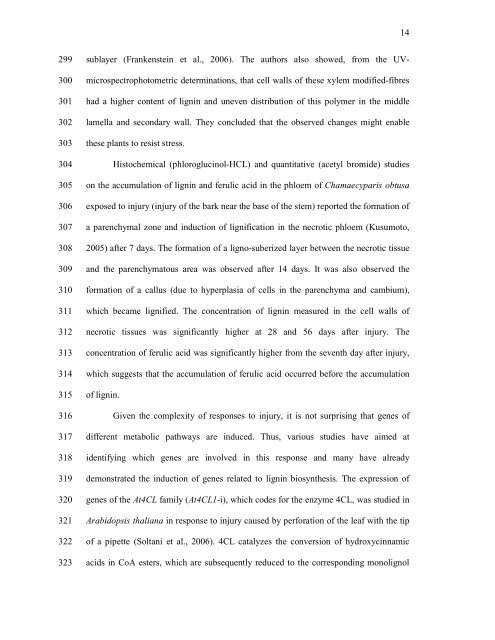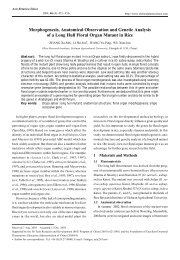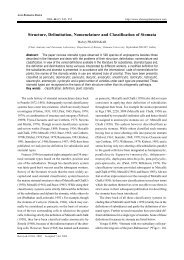Abiotic and biotic stresses and changes in the lignin ... - ResearchGate
Abiotic and biotic stresses and changes in the lignin ... - ResearchGate
Abiotic and biotic stresses and changes in the lignin ... - ResearchGate
Create successful ePaper yourself
Turn your PDF publications into a flip-book with our unique Google optimized e-Paper software.
14<br />
299<br />
300<br />
301<br />
302<br />
303<br />
304<br />
305<br />
306<br />
307<br />
308<br />
309<br />
310<br />
311<br />
312<br />
313<br />
314<br />
315<br />
316<br />
317<br />
318<br />
319<br />
320<br />
321<br />
322<br />
323<br />
sublayer (Frankenste<strong>in</strong> et al., 2006). The authors also showed, from <strong>the</strong> UVmicrospectrophotometric<br />
determ<strong>in</strong>ations, that cell walls of <strong>the</strong>se xylem modified-fibres<br />
had a higher content of lign<strong>in</strong> <strong>and</strong> uneven distribution of this polymer <strong>in</strong> <strong>the</strong> middle<br />
lamella <strong>and</strong> secondary wall. They concluded that <strong>the</strong> observed <strong>changes</strong> might enable<br />
<strong>the</strong>se plants to resist stress.<br />
Histochemical (phlorogluc<strong>in</strong>ol-HCL) <strong>and</strong> quantitative (acetyl bromide) studies<br />
on <strong>the</strong> accumulation of lign<strong>in</strong> <strong>and</strong> ferulic acid <strong>in</strong> <strong>the</strong> phloem of Chamaecyparis obtusa<br />
exposed to <strong>in</strong>jury (<strong>in</strong>jury of <strong>the</strong> bark near <strong>the</strong> base of <strong>the</strong> stem) reported <strong>the</strong> formation of<br />
a parenchymal zone <strong>and</strong> <strong>in</strong>duction of lignification <strong>in</strong> <strong>the</strong> necrotic phloem (Kusumoto,<br />
2005) after 7 days. The formation of a ligno-suberized layer between <strong>the</strong> necrotic tissue<br />
<strong>and</strong> <strong>the</strong> parenchymatous area was observed after 14 days. It was also observed <strong>the</strong><br />
formation of a callus (due to hyperplasia of cells <strong>in</strong> <strong>the</strong> parenchyma <strong>and</strong> cambium),<br />
which became lignified. The concentration of lign<strong>in</strong> measured <strong>in</strong> <strong>the</strong> cell walls of<br />
necrotic tissues was significantly higher at 28 <strong>and</strong> 56 days after <strong>in</strong>jury. The<br />
concentration of ferulic acid was significantly higher from <strong>the</strong> seventh day after <strong>in</strong>jury,<br />
which suggests that <strong>the</strong> accumulation of ferulic acid occurred before <strong>the</strong> accumulation<br />
of lign<strong>in</strong>.<br />
Given <strong>the</strong> complexity of responses to <strong>in</strong>jury, it is not surpris<strong>in</strong>g that genes of<br />
different metabolic pathways are <strong>in</strong>duced. Thus, various studies have aimed at<br />
identify<strong>in</strong>g which genes are <strong>in</strong>volved <strong>in</strong> this response <strong>and</strong> many have already<br />
demonstrated <strong>the</strong> <strong>in</strong>duction of genes related to lign<strong>in</strong> biosyn<strong>the</strong>sis. The expression of<br />
genes of <strong>the</strong> At4CL family (At4CL1-i), which codes for <strong>the</strong> enzyme 4CL, was studied <strong>in</strong><br />
Arabidopsis thaliana <strong>in</strong> response to <strong>in</strong>jury caused by perforation of <strong>the</strong> leaf with <strong>the</strong> tip<br />
of a pipette (Soltani et al., 2006). 4CL catalyzes <strong>the</strong> conversion of hydroxyc<strong>in</strong>namic<br />
acids <strong>in</strong> CoA esters, which are subsequently reduced to <strong>the</strong> correspond<strong>in</strong>g monolignol







